
Sassafras is a genus of three extant and one extinct species of deciduous trees in the family Lauraceae, native to eastern North America and eastern Asia. The genus is distinguished by its aromatic properties, which have made the tree useful to humans.

Acer rubrum, the red maple, also known as swamp maple, water maple, or soft maple, is one of the most common and widespread deciduous trees of eastern and central North America. The U.S. Forest Service recognizes it as the most abundant native tree in eastern North America. The red maple ranges from southeastern Manitoba around the Lake of the Woods on the border with Ontario and Minnesota, east to Newfoundland, south to Florida, and southwest to East Texas. Many of its features, especially its leaves, are quite variable in form. At maturity, it often attains a height around 30 m (100 ft). Its flowers, petioles, twigs, and seeds are all red to varying degrees. Among these features, however, it is best known for its brilliant deep scarlet foliage in autumn.
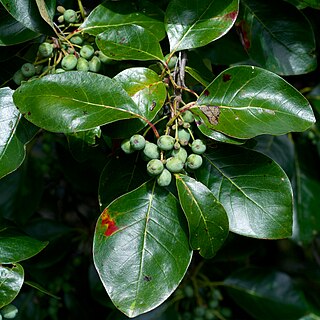
Nyssa sylvatica, commonly known as tupelo, black tupelo, black gum or sour gum, is a medium-sized deciduous tree native to eastern North America from the coastal Northeastern United States and southern Ontario south to central Florida and eastern Texas, as well as Mexico.

Liquidambar, commonly called sweetgum, gum, redgum, satin-walnut, styrax or American storax, is the only genus in the flowering plant family Altingiaceae and has 15 species. They were formerly often treated as a part of the Hamamelidaceae. They are native to southeast and east Asia, the eastern Mediterranean and North America. They are decorative deciduous trees that are used in the wood industry and for ornamental purposes.
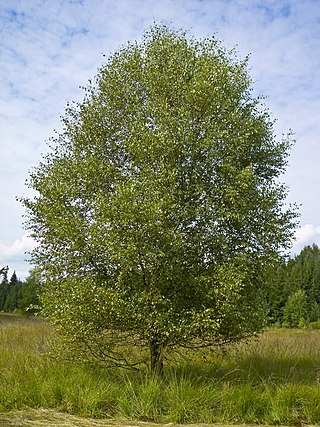
Betula pubescens, commonly known as downy birch and also as moor birch, white birch, European white birch or hairy birch, is a species of deciduous tree, native and abundant throughout northern Europe and northern Asia, growing farther north than any other broadleaf tree. It is closely related to, and often confused with, the silver birch, but grows in wetter places with heavier soils and poorer drainage; smaller trees can also be confused with the dwarf birch.

American sweetgum, also known as American storax, hazel pine, bilsted, redgum, satin-walnut, star-leaved gum, alligatorwood, gumball tree, or simply sweetgum, is a deciduous tree in the genus Liquidambar native to warm temperate areas of eastern North America and tropical montane regions of Mexico and Central America. Sweetgum is one of the main valuable forest trees in the southeastern United States, and is a popular ornamental tree in temperate climates. It is recognizable by the combination of its five-pointed star-shaped leaves and its hard, spiked fruits. It is currently classified in the plant family Altingiaceae, but was formerly considered a member of the Hamamelidaceae.

Acacia auriculiformis, commonly known as earleaf acacia, earpod wattle, auri, karuvel and aakashmani, is a fast-growing, crooked, gnarly tree in the family Fabaceae. It is native to Australia, Philippines, Indonesia, and Papua New Guinea. It grows up to 30 metres (98 ft) tall. Acacia auriculiformis has about 47,000 seeds per kilogram (21,000/lb).
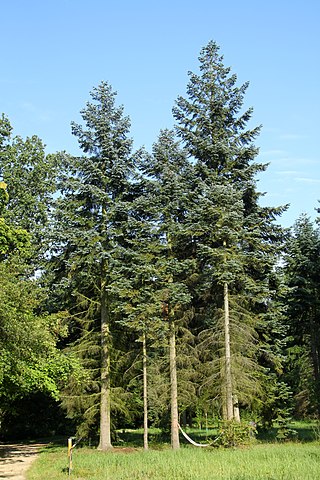
Abies procera, the noble fir, also called red fir and Christmas tree, is a species of fir native to the Cascade Range and Pacific Coast Ranges of the northwestern Pacific Coast of the United States. It occurs at altitudes of 300–1,500 meters (980–4,920 ft).

Nuytsia floribunda is a hemiparasitic tree found in Western Australia. The species is known locally as moodjar and, more recently, the Christmas tree or Western Australian Christmas tree. The display of intensely bright flowers during the austral summer coincides with the Christmas season.

Pittosporum tenuifolium is a small evergreen tree endemic to New Zealand – up to 10 m (33 ft) – commonly known as kōhūhū and black matipo, and by other Māori names kohukohu and tawhiwhi. Its small, very dark, reddish-purple flowers generally go unnoticed, and are scented only at night. The Latin tenuifolium means "slender-leaved"

Xanthorrhoea australis, the grass tree or austral grasstree, is an Australian plant. It is the most commonly seen species of the genus Xanthorrhoea. Its trunk can grow up to several metres tall and is often branched. In certain Aboriginal languages, it is called bukkup, baggup or kawee.

Commiphora myrrha, called myrrh, African myrrh, herabol myrrh, Somali myrrhor, common myrrh, is a tree in the family Burseraceae. It is one of the primary trees used in the production of myrrh, a resin made from dried tree sap. The tree is native to the Arabian Peninsula and to Africa. It is called 'mur' (المر) in Arabic, meaning bitter. It famously comes from Mecca, so it is called 'Mur Makki'.
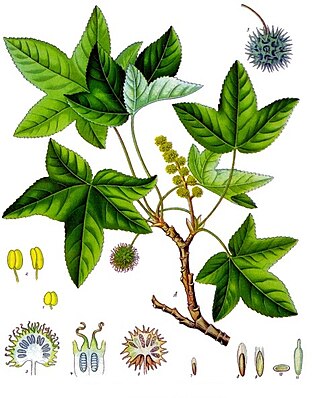
Liquidambar orientalis, commonly known as oriental sweetgum or Turkish sweetgum, is a deciduous tree in the genus Liquidambar, native to the eastern Mediterranean region, that occurs as pure stands mainly in the floodplains of southwestern Turkey and on the Greek island of Rhodes.

Chamaebatia foliolosa is a species of aromatic evergreen shrub in the rose family known by the common names mountain misery, bearclover, and tarweed. It is endemic to the mountains of California, where it grows in coniferous forests. The Miwok tribe's name for the plant was kit-kit-dizze. It was used as an herbal remedy for colds, coughs, rheumatism, chicken pox, measles, smallpox and other diseases.
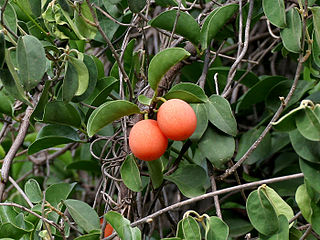
Ximenia americana, commonly known as tallow wood, hog plum, yellow plum, sea lemon, or pi'ut (Chamorro), is bush-forming shrub/small tree; a species from the Ximenia genus in the Olacaceae family. It is mainly found in the tropics, ranging from Africa, India and southeast Asia, to Australia, New Zealand, Pacific Islands, West Indies, Central, North and South America. It is especially common in Africa and South America. It is not domesticated so it is only found occurring in the wild.

Angophora floribunda, commonly known as the rough-barked apple, is a common woodland and forest tree of the family Myrtaceae native to Eastern Australia. Reaching 30 m (100 ft) high, it is a large tree with fibrous bark and cream-white flowers that appear over the Austral summer. It grows on alluvial soils on floodplains and along watercourses. Much of the land it grew on has been cleared for agriculture.
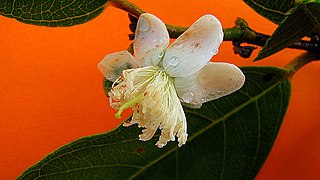
Psidium guineense is a species of guava.

Euclea crispa, commonly known as the blue guarri, is an Afrotropical plant species of the family Ebenaceae. The hardy and evergreen plants may form a dense stand of shrubs, or grow to tree size. It is widespread and common in the interior regions of southern Africa, and occurs northward to the tropics. Though some are present near the South African south and east coasts, they generally occur at middle to high altitudes. It is readily recognizable from its much-branched structure and dull bluish foliage colour. Those bearing lanceolate leaves may however resemble the Wild olive, another common species of the interior plateaus.

Liquidambar acalycina, Chang's sweetgum, is a species of flowering plant in the family Altingiaceae native to southern China. Growing to 30–50 ft (9.1–15.2 m) tall and 20–30 ft (6.1–9.1 m) broad. It is a medium-sized deciduous tree with three-lobed maple-like leaves that turn red in autumn before falling. It is monoecious, meaning both male and female flowers appear on the same plant. The flowers are insignificant, yellow/green in colour, and are followed by small gum-balls that persist on the tree until winter. The wood exudes a sweet-smelling resin when pierced, giving the tree its common name.

Garcinia cowa, commonly known as cowa fruit or cowa mangosteen is an evergreen plant with edible fruit native to Asia, India, Bangladesh, Myanmar, Malaysia, Vietnam, Laos, Cambodia, and southwest China. The tree is harvested from the wild for its edible fruits and leaves, which are used locally. Flowers are yellow, male & female flowers are separated.

























